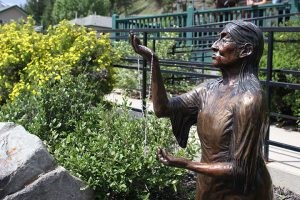
Long before Jasper became a national park the Aseniwuche Winewak or Rocky Mountain People, along with many other Indigenous groups in the region, called Jasper home.
To commemorate their historical connection to the park, the Jasper Yellowhead Museum and Achieves officially unveiled a four-foot bronze statue affectionately known as Kokum, which means grandmother in Cree.
ŌĆ£I think itŌĆÖs important because it recognizes the fact that our people used to live here,ŌĆØ said David MacPhee, president of the Aseniwuche Winewak Nation.
ŌĆ£For many years I think Parks Canada was really silent on that and I think for us to be able to come to the town of Jasper and have something like this acknowledges our existence.ŌĆØ
He was one of more than a dozen members of the Aseniwuche Winewak Nation that travelled from the Grande Cache area on June 23 to commemorate Lucy Wanyandie, the woman depicted by the statue.
ŌĆ£She was the matriarch of our community,ŌĆØ said MacPhee. ŌĆ£Out of our community probably close to half of the population existed because of her. Even though she might have been small in stature and she might not have been a highly educated person, when she spoke in our community she had a lot weight, a lot of authority.ŌĆØ
Among those in attendance for the ceremony was WanyandieŌĆÖs eldest daughter, Philomene Moberly, along with her other siblings.
ŌĆ£IŌĆÖm happy,ŌĆØ said Moberly, who is now 80 years old.
She said her mother was born in Grande Cache in 1919 and died at the age of 94.
For centuries the Aseniwuche Winewak lived in Jasper National Park, hunting, gathering and homesteading.
That all changed in 1907 when the federal government decided to establish Jasper Forest Park, evicting the Aseniwuche Winewak, as well as other Indigenous groups that frequented the park, because their traditional way of life was no longer permitted on protected land.
The sculpture, which depicts Wanyandie gathering berries and herbs, is part of a larger permanent exhibit inside the museum, which highlights the contribution the Aseniwuche Winewak people made to this region.
Among the dignitaries in attendance was Alberta artist Crystal C. Mossing, who created the sculpture.
ŌĆ£Art can help to heal and to also provide a safe entry point into discussions about difficult cultural topics,ŌĆØ said Mossing, who recalled installing the statue last fall with Andy Klimach, the former manager of the museum.
ŌĆ£I think itŌĆÖs a really proud day for Indigenous peoples not only from the Jasper area, but also throughout Albert and the country because we need to celebrate their contributions to this place,ŌĆØ said Klimach, who now lives in Grande Prairie.
The initial impetus to create the statue came in July 2014 when Parks Canada approached Klimach with a desire to commemorate and recognize JasperŌĆÖs Indigenous history.
Despite having only a $5,000 budget, Klimach jumped at the opportunity and began collaborating with Parks Canada and Rachelle McDonald from the Aseniwuche Winewak Nation to make it a reality.
Over the next year or so the group was able to secure more funding and brought Mossing on board to create the statue.
ŌĆ£Crystal was by far the most enthusiastic in the whole process so we chose her,ŌĆØ said Klimach.
Mayor Richard Ireland and MLA Eric Rosendahl also spoke during the ceremony.
ŌĆ£As art so often does, it speaks to us on several levels,ŌĆØ Ireland said, earlier acknowledging Jasper National Park is located in Treaty 6 and Treaty 8 territories as well as in the traditional territories of several other Indigenous groups.
ŌĆ£Grandmothers have always been key in all cultures to the passing of history, knowledge and understanding so it is so very fitting then that this small, bronze statue, this Kokum, can relate to all of us so elegantly on so many levels and in a language without word, the historical connection of Indigenous people to this valley.ŌĆØ
Rosendahl share a similar message on behalf of Premier Rachel Notley.
ŌĆ£This monument stands as a reminder of the rich history, heritage and traditions of the Indigenous peoples of West Yellowhead,ŌĆØ said Rosendahl.
ŌĆ£The wise features of Kokum speak to the strength, courage and resilience of a people who in the face of numerous challenges continued to stand strong as a community. A community that in honouring the past proudly looks towards the future.ŌĆØ
Paul Clarke
[email protected]
